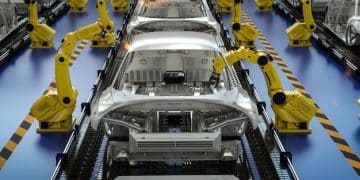Electric Vehicle Battery Shortage: Lithium Supply Gap to Hit by 2027?

Industry experts are predicting a potential lithium supply gap as early as 2027, which could significantly impact electric vehicle production and prices, raising concerns about the affordability and accessibility of EVs for consumers.
The automotive industry is undergoing a massive shift toward electric vehicles (EVs), but a looming question mark hangs over the future: Is there enough battery material to fuel this revolution? The Electric Vehicle Battery Material Shortage? Industry Experts Predict Lithium Supply Gap by 2027 – What It Means for Electric Vehicle Prices, impacting global EV adoption.
The Impending Lithium Supply Crunch
The increasing demand for electric vehicles (EVs) has put a spotlight on the critical materials that power their batteries. Among these materials, lithium stands out as a key component, and concerns are growing about a potential supply shortage in the coming years.
Several industry experts predict a significant lithium supply gap by 2027. Understanding the factors contributing to this potential shortage is crucial for anyone following the EV market.
Rising Demand for Lithium
The global push for electrification in the transportation sector has led to an unprecedented surge in demand for lithium. As more automakers commit to producing EVs and governments implement policies promoting their adoption, the need for lithium-ion batteries continues to escalate.
This demand is further fueled by the growing energy storage market, where lithium-ion batteries are used in grid-scale storage systems, residential energy storage, and portable electronic devices.

Challenges in Lithium Production
While lithium is relatively abundant in the Earth’s crust, extracting and processing it into battery-grade material is a complex and resource-intensive process. The two primary methods of lithium extraction are:
- Brine Extraction: This involves pumping lithium-rich brine from underground reservoirs into evaporation ponds, where the water evaporates over several months, leaving behind lithium salts.
- Hard Rock Mining: This involves mining lithium-bearing minerals, such as spodumene, from hard rock deposits and then processing the ore to extract the lithium.
Both methods face challenges, including long lead times for new projects, environmental concerns related to water usage and land disturbance, and geopolitical risks associated with the concentration of lithium resources in a few countries.
The rising demand creates a strain on production capacity and infrastructure, leading to potential delays and bottlenecks in the supply chain.
In conclusion, the increasing demand for lithium, coupled with the inherent challenges in its production, is creating a perfect storm that could lead to a significant supply shortage in the coming years.
The Ripple Effect on Electric Vehicle Prices
A lithium supply shortage has far-reaching implications for the electric vehicle industry. One of the most immediate and noticeable effects would be on the prices of EVs.
As the cost of lithium rises due to scarcity, battery manufacturers would likely pass on these increased costs to automakers, who in turn may have to increase the prices of their electric vehicles.
Impact on Battery Costs
Lithium is a crucial component in lithium-ion batteries, which constitute a significant portion of the overall cost of an EV. A lithium supply shortage would inevitably drive up battery costs, potentially reversing the recent trend of declining battery prices.
Higher battery prices could make it more difficult for automakers to achieve cost parity between EVs and conventional gasoline-powered vehicles, potentially slowing down the transition to electric mobility.
Electric Vehicle Affordability
One of the primary barriers to EV adoption is their higher upfront cost compared to gasoline-powered cars. A lithium supply shortage and subsequent price increases could exacerbate this issue, making EVs less affordable for many consumers.
This could disproportionately affect lower- and middle-income households, hindering the widespread adoption of EVs and potentially widening the gap between the wealthy and those who cannot afford cleaner transportation options.
In summary, the potential lithium supply gap would affect affordability of electric vehicles due to the high cost of vehicles making them not accessible to the majority of people.

Government Subsidies and Incentives
To mitigate the impact of rising EV prices, governments may need to increase subsidies and incentives for EV purchases. Tax credits, rebates, and other financial incentives can help offset the higher upfront costs and make EVs more accessible to a broader range of consumers.
However, relying solely on government subsidies is not a sustainable long-term solution. Addressing the underlying supply issues and promoting innovation in battery technology are crucial for ensuring the long-term affordability of EVs.
To conclude, a lithium supply shortage would likely lead to higher EV prices, impacting affordability and potentially slowing down the transition to electric mobility, and requiring governments to increase subsidies to offset the prices.
Alternative Battery Technologies
To mitigate the risks associated with a lithium supply shortage, researchers and companies are exploring alternative battery technologies that rely on more abundant and readily available materials. These technologies offer the potential to reduce the dependence on lithium and diversify the battery supply chain.
Multiple alternatives are being looked at to decrease the demand for lithium-based batteries and help the growth of the EV market and its affordability.
Sodium-Ion Batteries
Sodium is chemically similar to lithium and is much more abundant in the Earth’s crust. Sodium-ion batteries offer the potential to provide a lower-cost alternative to lithium-ion batteries, particularly for applications where energy density is less critical.
- Lower Cost: Sodium is cheaper and more abundant than lithium, which could translate into lower battery costs.
- Improved Safety: Sodium-ion batteries are generally considered to be safer than lithium-ion batteries, with a lower risk of thermal runaway.
- Sustainable Materials: The use of abundant materials promotes a more sustainable and resilient supply chain.
Solid-State Batteries
Solid-state batteries replace the liquid electrolyte found in conventional lithium-ion batteries with a solid electrolyte. This technology offers several potential advantages, including higher energy density, improved safety, and faster charging times.
Solid-state batteries can also potentially use lithium metal anodes, which could further increase energy density and reduce reliance on other battery materials.
Other Promising Technologies
Beyond sodium-ion and solid-state batteries, other alternative battery technologies are being explored, including:
- Lithium-Sulfur Batteries: These batteries use sulfur as the cathode material, which is abundant and inexpensive.
- Magnesium-Ion Batteries: Magnesium is another abundant element that could potentially be used as the active material in batteries.
- Aluminum-Ion Batteries: Aluminum is lightweight, abundant, and has a high theoretical energy density.
In conclusion, while lithium-ion batteries currently dominate the EV market, alternative battery technologies offer promising avenues for reducing reliance on lithium and diversifying the battery supply chain, but the need to test these alternatives are also present for them to prove effective.
Recycling and Sustainable Sourcing
In addition to exploring alternative battery technologies, recycling lithium-ion batteries and promoting sustainable sourcing practices are crucial for mitigating the risks associated with a lithium supply shortage. Battery recycling can recover valuable materials from end-of-life batteries and reduce the need for virgin lithium mining, reducing the demand and the potential of a supply shortage.
Finding new ways to source the batteries can help make them more affordable. Reusing the materials already in the market creates a more sustainable approach to the industry.
Battery Recycling Infrastructure
Establishing a robust battery recycling infrastructure is essential for capturing the value of end-of-life lithium-ion batteries. This infrastructure should include:
- Collection and Sorting Systems: Efficient systems for collecting and sorting end-of-life batteries from various sources.
- Recycling Facilities: Specialized facilities capable of safely and efficiently recovering valuable materials from batteries.
- Regulatory Frameworks: Clear and consistent regulations that promote battery recycling and hold producers accountable for end-of-life management.
Sustainable Mining Practices
Promoting sustainable mining practices is crucial for minimizing the environmental and social impacts of lithium extraction. This includes:
- Water Management: Responsible water usage practices to minimize the impact on local water resources.
- Land Rehabilitation: Rehabilitating mining sites after operations have ceased to restore the landscape and biodiversity.
- Community Engagement: Engaging with local communities to address concerns and ensure that mining operations benefit the local population.
Extended Producer Responsibility
Implementing extended producer responsibility (EPR) schemes can incentivize producers to design batteries that are easier to recycle and to take responsibility for the end-of-life management of their products.
EPR schemes can also provide funding for battery recycling infrastructure and promote the development of sustainable battery designs.
In summary, recycling lithium-ion batteries and promoting sustainable sourcing practices are essential for mitigating the risks associated with the lithium supply shortage, but those solutions require a group effort from private and public sectors.
Geopolitical Factors and Supply Chain Security
The concentration of lithium resources in a few countries raises concerns about geopolitical risks and supply chain security. Diversifying the sources of lithium and securing access to critical materials are crucial for ensuring a stable and resilient battery supply chain.
When one or two countries control a market, costs can go up, and external factors such as political distress can dramatically alter the market and costs or resources.
Geographic Concentration of Lithium Resources
A significant portion of the world’s lithium resources is concentrated in a few countries, including:
- Chile: Home to vast lithium brine deposits in the Atacama Desert.
- Australia: A major producer of lithium from hard rock mines.
- Argentina: Another country with significant lithium brine resources.
This concentration of resources makes the battery supply chain vulnerable to geopolitical risks, such as trade disputes, political instability, and resource nationalism.
Diversifying Lithium Sources
To mitigate these risks, it is essential to diversify the sources of lithium by:
- Developing Domestic Lithium Production: Encouraging the development of lithium resources within countries that have a high demand for batteries.
- Establishing Strategic Partnerships: Forming partnerships with countries that have stable political environments and reliable supply chains.
- Investing in Lithium Exploration: Supporting exploration efforts to discover new lithium resources around the world.
Supply Chain Resilience
Building a resilient supply chain requires:
- Transparency: Increased transparency throughout the supply chain to identify potential risks and vulnerabilities.
- Redundancy: Establishing alternative sources of supply for critical materials.
- Collaboration: Collaboration among governments, industry, and research institutions to address supply chain challenges.
In conclusion, diversifying the sources of lithium and securing access to critical materials are crucial for ensuring a stable and resilient battery supply chain, but a more diverse supply chain would prevent any issues with supply and demand within geopolitical distress.
Innovation and Technological Advancements
Continued innovation and technological advancements in battery technology and lithium extraction methods are essential for mitigating the risks associated with a potential lithium supply shortage. These advancements can improve battery performance, reduce material usage, and enhance the efficiency of lithium extraction.
As electric vehicles become more prominent, the creation of more efficient batteries will make a big impact in the marketplace. These batteries will need to be made cheaper and more reliable.
Advanced Battery Chemistries
Research and development efforts are focused on developing advanced battery chemistries that:
- Increase Energy Density: Improving the amount of energy that can be stored in a given volume or weight of battery.
- Extend Battery Lifespan: Increasing the number of charge-discharge cycles that a battery can withstand before its performance degrades.
- Improve Safety: Reducing the risk of thermal runaway and other safety hazards.
Efficient Lithium Extraction Methods
New methods for extracting lithium from brine and hard rock deposits are being developed to:
- Reduce Water Consumption: Minimizing the amount of water used in brine extraction processes.
- Lower Energy Consumption: Reducing the energy required for lithium extraction and processing.
- Minimize Environmental Impact: Mitigating the environmental impacts of lithium mining and processing.
Digitalization and Automation
Digitalization and automation technologies can be used to:
- Optimize Battery Production: Improving the efficiency and precision of battery manufacturing processes.
- Monitor Battery Performance: Tracking the performance of batteries in real-time to optimize their operation and predict their remaining lifespan.
- Manage Battery Recycling: Streamlining the collection, sorting, and recycling of end-of-life batteries.
In summary, these innovations are essential for mitigating the risk of a lithium supply shortage and ensuring the long-term sustainability of batteries and lithium extraction methods.
| Key Point | Brief Description |
|---|---|
| ⚠️ Lithium Shortage | Experts predict a lithium supply gap by 2027. |
| 💰 EV Prices | Lithium scarcity may increase EV battery and vehicle costs. |
| 🔋 Alternatives | Sodium-ion and solid-state batteries are being explored. |
| ♻️ Recycling | Battery recycling is crucial for material recovery and sustainability. |
Frequently Asked Questions
▼
The surge in EV production coupled with challenges in lithium extraction and processing are key factors straining the supply chain, but the demand for electric vehicles plays a big role.
▼
Reduced lithium availability could raise battery costs, translating to higher EV prices, and make EVs less affordable especially to some markets that have less purchasing power.
▼
Sodium-ion and solid-state batteries are promising alternatives since they offer lower costs, better safety, and decreased demands, helping with the lithium dilemma.
▼
Battery recycling recovers valuable components, reducing our need for lithium mining, and promotes a more sustainable and economical process in the overall price.
▼
The heavy bulk of resources being in just a few countries creates geopolitical risks that can disrupt supply. Diversifying supplier helps reduce those risks from certain factors.
Conclusion
In conclusion, the potential lithium supply gap poses a significant challenge to the electric vehicle industry, but a surge in EV production, and the rising demand will require innovative changes for the future of this market. Alternative battery technologies, recycling initiatives, sustainable sourcing practices, and geopolitical diversification can all play a role in ensuring a sustainable and affordable electric future.





